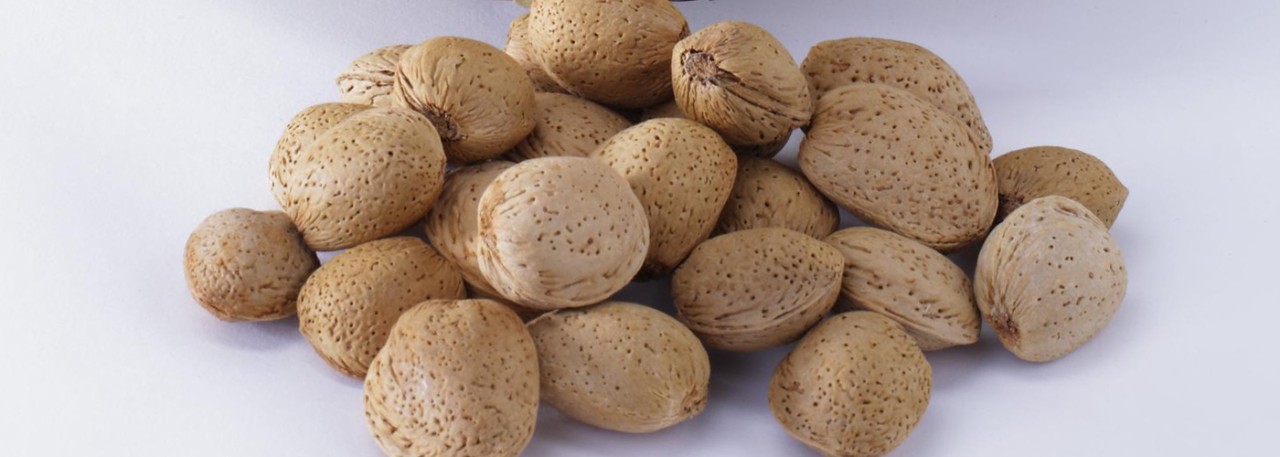.png.transform/rendition-xs/image_image%20(1).png)
Almendra de Mallorca PGI
Fruit from the almond tree (Prunus amygdalus) traditionally grown on the island of Majorca, for human consumption and sold raw or toasted, either with skin or peeled. Comprising a set of varieties and ecotypes that are perfectly adapted to soil and climate conditions in Mallorca.
The almonds may be sold either raw or toasted. In both cases, depending on the absence or presence of the tegument (brown outer skin), with the skin intact or peeled.
Tasting notes
Raw Almonds: both the surface and the embryo are white or ivory colored, with a matte appearance. Firm texture, not sticky and with an oily feel. Slightly sweet flavor, neither acid nor bitter. Intense aroma with nutty hints. In the presentation with skin, the nut is covered by its brown colored and wrinkly textured tegument.
Toasted Almonds: the peeled version has a vanilla to light brown colored surface and embryo, a shiny appearance and oily feel. Hard, friable and crunchy. Slightly sweet flavor, not at all acid or astringent and with a touch of bitterness provided by the toasting process. Intense, roasted and caramelized aroma. In the presentation with skin, the nut is covered by its dark brown tegument, which is easy to remove and is characterized by its friability.
Other notes
Chemical properties:
- Raw Almond:
Moisture content: ≤6.5%
Fat content: ≥55.0% (over dry weight)
Oleic and linoleic acid content: ≥88% of total fat
- Toasted Almond:
Moisture content: ≤2.0%
Fat content: ≥55% (over dry weight)
Oleic and linoleic acid content: ≥88% of total fat.
Production / Processing method
Cultivation: Production plantations are arranged in a spacing of 5x3 to 11x11 meters. This makes best use of water and sunlight, as well as providing traditional grazing land for sheep. Maintenance pruning is generally done every 4 to 5 years. Fertilizing is done in the traditional way by using fresh manure from the sheep grazed in the plantations and dug into the soil. Fertilizers not obtained from the plantation may be used as supplement only if this practice is insufficient. The plantations are irrigated by water produced by Majorca's normal rainfall and/or by additional irrigation methods. No additional irrigation is used three weeks before harvesting to safeguard the quality of the almonds.
Harvesting takes place from the second half of August through to late October. Harvesting is done manually or using vibrators that shake the trees and cloths to catch the almonds. Harvesting is carried out with the utmost care to prevent the trees from being damaged, which may harm the quality of nuts produced in the future or cause infections. Once harvesting is completed, no almond tree may have more than 12 almonds left on it to guarantee the quality of the next crop. The epicarpal membrane is removed manually or mechanically from the rest of the nut, leaving the almond in its shell and ready to be taken to the collection plant.
Processing:
Once they reach the handling facility, the almonds are checked for moisture content. If their moisture content is found to be in excess of 6.5%, they undergo a drying process until this figure is achieved.
Storage of almonds in their shells is done in a clean, dry area with sufficient natural ventilation and protected from direct sunlight.
Depending on the various forms of presentation, other processes the almonds pass through include the following:
Shelling:
The almonds are previously moistened by soaking in water for a maximum of 24 hours.
Once moistened, the almonds are split by splitting or shelling machines.
The kernels are separated from the shells by sieving and then winnowing using separating machines consisting of different sized sieves and fan speeds. The kernels obtained are dried using hot air at a temperature of between 40º and 60ºC until they acquire a moisture content of less than 6.5%.
Peeling:
Peeling consists of removing the tegument or skin from the almonds and includes the following operations:
a) Prior scalding for 3 to 4 minutes in water heated to a temperature of over 90ºC.
b) Mechanical peeling by passing the almonds through two rubber rollers that separate the tegument from the kernel.
c) Removal of the tegument by means of a constant stream of air.
d) Drying the peeled kernel with hot air at a temperature of between 40 and 60ºC.
Toasted:
The toasting process is used only for toasted almonds and is done in special ovens that ensure the nuts are evenly toasted, at a temperature of 160ºC±20ºC for 45±10 minutes.
Packaging:
The almonds covered by the Protected Geographical Indication are sold in homogeneous batches and in packaging holding no more than 25 kilos.
Geography / Relief and climate
The island of Majorca covers a total surface area of 3626 km2 and is the largest of the Balearic Islands. It is in the central-western sector of the western Mediterranean, between latitudes 40º05’17’’ and 38º40’27’’ and longitudes 1º17’23’’ and 3º50’23’’. The distinctive physical, chemical and organoleptic properties of "Almendras de Mallorca" almonds are determined by the soil and climate conditions in the geographical area where they grow. Chalky soils low in organic matter content, medium levels of rainfall and many hours of sunlight result in a low yield per hectare, with a high average fat content (59%), higher than almonds grown in other regions.
Regulatory Council
Institut de Qualitat Agroalimentària de les Illes Balears (Balearic Islands Institute of Food Quality)
Conselleria d'Agricultura, Medi Ambient i Territori
Tel: (+34) 971 886 588
www.illesbalearsqualitat.es
Sources:
- Spanish Ministry of Agriculture
The almonds may be sold either raw or toasted,with the skin intact or peeled.


Palma de Mallorca (Balearic Islands)
